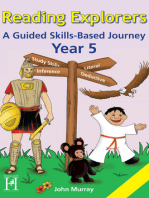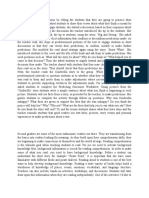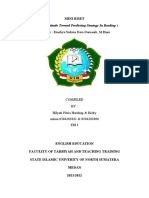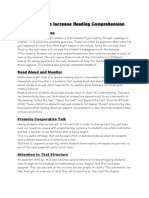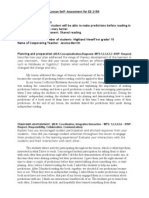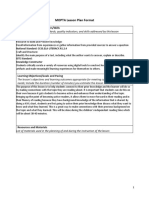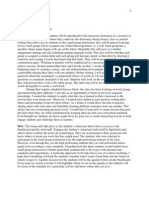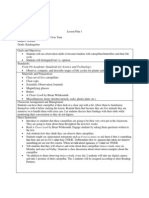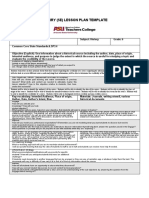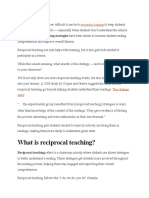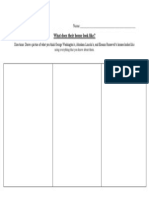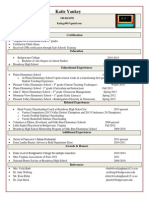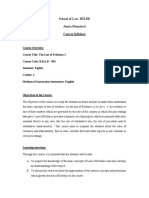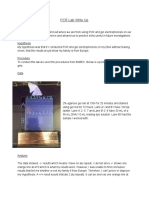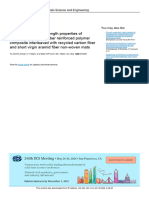Instructional Strategies Redo
Instructional Strategies Redo
Uploaded by
api-239308420Copyright:
Available Formats
Instructional Strategies Redo
Instructional Strategies Redo
Uploaded by
api-239308420Original Title
Copyright
Available Formats
Share this document
Did you find this document useful?
Is this content inappropriate?
Copyright:
Available Formats
Instructional Strategies Redo
Instructional Strategies Redo
Uploaded by
api-239308420Copyright:
Available Formats
Having students make predictions helps them gain a deeper meaning of the content.
It allows students to make connections to their prior knowledge and activate their learning. This strategy is especially useful in reading, but can also be conducted in other content areas.
How to use in the classroom with reading?
Start by having the students make predictions just by looking at the books cover or from the title of the book. Students should predict what they think the book is going to be about. Have a small group or class discussion about their predictions. Then have the students read into the text. At a certain point have the students stop and from the text they have read, they need to make a new prediction for what they think will occur next. Repeat this process multiple times throughout the book and have the students document their predictions at every stopping point. It is important that students keep track of their predictions, so they can compare their predictions to what they now know. Students can use Semantic maps to document their predictions and then what really happened. Once the book is over have the students predict what they think would happen if the author made a sequel.
https://www.pinterest.com/1stschoolhouse/makingpredictions/
Forming Predictions can be used in any grade level and for any subject. Incorporating predictions into reading is extremely important for a childs ability to comprehend the text that they are reading. Every teacher needs to use prediction strategies in their classrooms!
http://bvillekids.blogspot.com/2011/05/summer-readingprogram-begins-june-6th.html
References Dean, C.B., Hubbell, E.R., Pitler, H, & Stone, B. (2012) Classroom Instruction that Works Research-Based Strategies for Increasing Student Achievement . Danvers, MA: McREL Robb, L. (2013) Reading clinic: use predictions to help kids think deeply about books. Scholastic. Retrieved November 25, 2013 from http://www.scholastic.com/teachers/lesson-plan/reading-clinic-use-predictionshelp-kids-think-deeply-about-books. Fries-Gaither, J. (Feb. 2011) Making predictions: a strategy for reading and science learning. Beyond weather & the water cycle. Retrieved November 25, 2013 from http://beyondweather.ehe.osu.edu/issue/the-sun-and-earths-climate/makingpredictions-a-strategy-for-reading-and-science-learning. (2013) Predicting. TeacherVision. Retrieved November 25,2013 from https://www.teachervision.com/skill-builder/reading/48711.html.
You might also like
- Cooperative Discipline PaperDocument6 pagesCooperative Discipline Paperapi-239308420No ratings yet
- Predicting Events S8Document10 pagesPredicting Events S8Ha Phương LêNo ratings yet
- Explicit InstructionDocument4 pagesExplicit Instructionapi-349670108No ratings yet
- Co Prehension LessonDocument2 pagesCo Prehension LessonShannon may torremochaNo ratings yet
- Portfolio Assignment Unit 5 5281Document2 pagesPortfolio Assignment Unit 5 5281asmaesaoud43No ratings yet
- Reaction Review Guide: by (Author), (Editor), (Editor)Document5 pagesReaction Review Guide: by (Author), (Editor), (Editor)api-298356696No ratings yet
- Mini Research (HILYA & KIKI)Document7 pagesMini Research (HILYA & KIKI)tara amalyaNo ratings yet
- Lesson Plan Template: Essential QuestionDocument13 pagesLesson Plan Template: Essential Questionapi-534597126No ratings yet
- Cep Lesson Plan 2Document9 pagesCep Lesson Plan 2api-690650522No ratings yet
- Reading ProjectDocument4 pagesReading ProjectWulandariNo ratings yet
- Subject/Grade: Gr.1 English Lesson Title: Think Aloud Teacher: Miss. Marcotte Stage 1: Identify Desired ResultsDocument2 pagesSubject/Grade: Gr.1 English Lesson Title: Think Aloud Teacher: Miss. Marcotte Stage 1: Identify Desired Resultsapi-402325503No ratings yet
- Supporting A Positive Student Field Experiece BDocument8 pagesSupporting A Positive Student Field Experiece Bapi-525697608No ratings yet
- Study of Student Achievement 2Document23 pagesStudy of Student Achievement 2api-543821252No ratings yet
- Interdisciplinary Teaching LPDocument6 pagesInterdisciplinary Teaching LPJenny Bee Cariaso IgneNo ratings yet
- Reciprocal TeachingDocument3 pagesReciprocal TeachingArief Al HakimNo ratings yet
- Code Talker - Day 3 LPDocument2 pagesCode Talker - Day 3 LPapi-206642598No ratings yet
- Wilson Jessica LearningunitDocument7 pagesWilson Jessica Learningunitapi-540125872No ratings yet
- Vocabulary Lesson PlanDocument4 pagesVocabulary Lesson Planapi-708439742No ratings yet
- Ued 495-496 Spivey Stacy Artifact Best Practices HandbookDocument22 pagesUed 495-496 Spivey Stacy Artifact Best Practices Handbookapi-337457106No ratings yet
- Strategy CatalogueDocument5 pagesStrategy Catalogueapi-288560316No ratings yet
- Instructional Strategies That Facilitate Learning Across Content AreasDocument21 pagesInstructional Strategies That Facilitate Learning Across Content AreasPunchGirl ChannelNo ratings yet
- Supervisor Lesson Plan - TornadoesDocument5 pagesSupervisor Lesson Plan - Tornadoesapi-247277013No ratings yet
- Educ220 Statement of Informed Beliefs PaperDocument9 pagesEduc220 Statement of Informed Beliefs Paperapi-637591838No ratings yet
- Lesson Plan Outline Read Comprehension 400 LevelDocument4 pagesLesson Plan Outline Read Comprehension 400 Levelapi-307144469No ratings yet
- Ued 496 Mabe Hannah Reflection of Lesson Plan 1Document6 pagesUed 496 Mabe Hannah Reflection of Lesson Plan 1api-580326561No ratings yet
- Reading and Writing StrategiesDocument2 pagesReading and Writing Strategiesapi-528968067No ratings yet
- Setting of BookDocument11 pagesSetting of BookGracie O. ChingNo ratings yet
- Goal 7 8 - Planning For Instruction Instruction Strategies Framing StatementDocument6 pagesGoal 7 8 - Planning For Instruction Instruction Strategies Framing Statementapi-665661592No ratings yet
- Lesson 3.1Document7 pagesLesson 3.1hansel krakersNo ratings yet
- Week 4 Learning Map Assignment Language and Literacy Sabrina BarreraDocument13 pagesWeek 4 Learning Map Assignment Language and Literacy Sabrina Barreraapi-445517432No ratings yet
- Portfolio Asignment Educ 5281 Unit 7Document3 pagesPortfolio Asignment Educ 5281 Unit 7asmaesaoud43No ratings yet
- Vanderkleyracheled 35026 SterlingstratagiesDocument4 pagesVanderkleyracheled 35026 Sterlingstratagiesapi-287419854No ratings yet
- 10 Strategies To Increase ReadingDocument2 pages10 Strategies To Increase ReadingAdil ChaudhryNo ratings yet
- Lesson Plan Template: Essential QuestionDocument6 pagesLesson Plan Template: Essential Questionapi-531359183No ratings yet
- ThirdlessonplanselfassessDocument3 pagesThirdlessonplanselfassessapi-207969366No ratings yet
- Detailed Lesson Preparation Guide: Elementary EducationDocument3 pagesDetailed Lesson Preparation Guide: Elementary Educationapi-355728225No ratings yet
- Lesson Plan Template: Essential QuestionDocument6 pagesLesson Plan Template: Essential Questionapi-531359505No ratings yet
- Classroom Modeling - PhippsDocument8 pagesClassroom Modeling - Phippsapi-399906068No ratings yet
- Inquiry (5E) Lesson Plan TemplateDocument2 pagesInquiry (5E) Lesson Plan Templateapi-488069675No ratings yet
- Anticipation Guides: Using Prediction To Promote Learning From TextDocument6 pagesAnticipation Guides: Using Prediction To Promote Learning From TextHana TsukushiNo ratings yet
- MOPTA Lesson Plan Format: Standards/Quality Indicators/SkillsDocument6 pagesMOPTA Lesson Plan Format: Standards/Quality Indicators/Skillsapi-356577739No ratings yet
- Inquiry 2 AllDocument16 pagesInquiry 2 Allapi-255591458No ratings yet
- Day 1Document8 pagesDay 1api-411680549No ratings yet
- Sarabucholtzed215r SupervisorobservationDocument5 pagesSarabucholtzed215r Supervisorobservationapi-241878694No ratings yet
- Chapter 11 Journal EntryDocument2 pagesChapter 11 Journal Entryapi-285702156No ratings yet
- Mary Wears What She Wants by Keith Negley, Which Helped My Students To Quickly Grasp The MessageDocument2 pagesMary Wears What She Wants by Keith Negley, Which Helped My Students To Quickly Grasp The Messageapi-580356455No ratings yet
- Nancy Levit EditsDocument5 pagesNancy Levit Editsty70001No ratings yet
- Synthesisofchapter 23Document5 pagesSynthesisofchapter 23api-316366367No ratings yet
- From PA Academic Standards For Science and TechnologyDocument5 pagesFrom PA Academic Standards For Science and TechnologyHyein YunNo ratings yet
- 01 Prediction GuideDocument5 pages01 Prediction Guideapi-449554197No ratings yet
- Guided Reading - Dra AssignmentDocument7 pagesGuided Reading - Dra Assignmentapi-286060600No ratings yet
- Lesson Plan 5Document3 pagesLesson Plan 5api-265324068No ratings yet
- Learning About Your Students CUR 520Document5 pagesLearning About Your Students CUR 520Lucy CeciliaNo ratings yet
- Strategies Week 7Document9 pagesStrategies Week 7Mr. Jaymar AragoNo ratings yet
- Supervisorobservedlesson 2Document5 pagesSupervisorobservedlesson 2api-295253793No ratings yet
- Lesson Plan Template: Essential QuestionDocument7 pagesLesson Plan Template: Essential Questionapi-531361307No ratings yet
- Inquiry (5E) Lesson Plan TemplateDocument2 pagesInquiry (5E) Lesson Plan Templateapi-490031600No ratings yet
- Reciprocal Teaching by Akashdeep KaurDocument21 pagesReciprocal Teaching by Akashdeep KaurakashNo ratings yet
- Formal Observation Reflection Lesson StudyDocument3 pagesFormal Observation Reflection Lesson Studyapi-285422446100% (1)
- What Does Their House Look LikeDocument1 pageWhat Does Their House Look Likeapi-239308420No ratings yet
- Katie ResumeDocument1 pageKatie Resumeapi-239308420No ratings yet
- Reflective EssayDocument21 pagesReflective Essayapi-239308420No ratings yet
- Lesson Plan Day4Document4 pagesLesson Plan Day4api-239308420No ratings yet
- Post Patriotisim TestDocument5 pagesPost Patriotisim Testapi-239308420No ratings yet
- Classroom Managment ModelDocument18 pagesClassroom Managment Modelapi-239308420100% (1)
- KRL Advised and BetterDocument3 pagesKRL Advised and Betterapi-239308420No ratings yet
- Railroad Lesson PlanDocument4 pagesRailroad Lesson Planapi-239308420No ratings yet
- Practice Test 2: Câu 1. Câu 2. Câu 3. Câu 4. Câu 5Document3 pagesPractice Test 2: Câu 1. Câu 2. Câu 3. Câu 4. Câu 5Duy HưngNo ratings yet
- Storm Glass/Dishwasher (BT) User ManualDocument14 pagesStorm Glass/Dishwasher (BT) User ManualSteveyNo ratings yet
- D C S Brixton Senior High School Grade 11 Introduction To World Religions and Belief SystemsDocument2 pagesD C S Brixton Senior High School Grade 11 Introduction To World Religions and Belief SystemsJenifer Buan-Bartolome100% (1)
- Covid QuestionnaireDocument1 pageCovid QuestionnaireAshher UsmaniNo ratings yet
- 1 - Slides GA Tipologia de Indicadores Ambientais AEA 21 - 22Document15 pages1 - Slides GA Tipologia de Indicadores Ambientais AEA 21 - 22H. LisbonNo ratings yet
- NVS - Physics - Class XI - 2020-21aDocument5 pagesNVS - Physics - Class XI - 2020-21aKartik PatilNo ratings yet
- Chapter 3 - Concept Questions and ExercisesDocument3 pagesChapter 3 - Concept Questions and ExercisesAnh TramNo ratings yet
- School of Law, HILSR Jamia Hamdard Course SyllabusDocument4 pagesSchool of Law, HILSR Jamia Hamdard Course SyllabusAdv ShahnawazNo ratings yet
- LC46 52d82uDocument222 pagesLC46 52d82uDíaz Rivero Cesar EnriqueNo ratings yet
- Breakdown in Solid DielectricsDocument4 pagesBreakdown in Solid DielectricsmadhueeNo ratings yet
- Introduction in Conservative DentistryDocument31 pagesIntroduction in Conservative Dentistryhind shaban100% (1)
- Vanguard Technical Specification - EN PDFDocument1 pageVanguard Technical Specification - EN PDFsoumyajit maityNo ratings yet
- Geria Prelim 1 1Document48 pagesGeria Prelim 1 1SVPSNo ratings yet
- Design and Simulation of Hydrogen Peroxide Plant: Manufacturing ProcessesDocument5 pagesDesign and Simulation of Hydrogen Peroxide Plant: Manufacturing Processesdfeor shenoyNo ratings yet
- CBTDocument13 pagesCBTZe SheikhNo ratings yet
- Medicinal Property of Murraya Koenigii PDFDocument4 pagesMedicinal Property of Murraya Koenigii PDFpandaypiraNo ratings yet
- What Henri Bedros Kifa Claims About Assyrians & Arameans ImpliesDocument8 pagesWhat Henri Bedros Kifa Claims About Assyrians & Arameans ImpliesArameanFactsNo ratings yet
- DST Tools Catalog PDF FreeDocument103 pagesDST Tools Catalog PDF FreeReza AsakerehNo ratings yet
- Physiology U-3 Excitable Nervous TissueDocument122 pagesPhysiology U-3 Excitable Nervous Tissuesinte beyuNo ratings yet
- SDD Example For Web ProjectDocument21 pagesSDD Example For Web ProjectDeJaVuNo ratings yet
- Andrew Rosenberg - Lecture 14: Neural NetworksDocument50 pagesAndrew Rosenberg - Lecture 14: Neural NetworksRoots999No ratings yet
- Maths emDocument396 pagesMaths emSri D0% (1)
- PCR Lab Write UpDocument3 pagesPCR Lab Write Upapi-347575155No ratings yet
- Attahu 2022 IOP Conf. Ser. Mater. Sci. Eng. 1225 012005Document12 pagesAttahu 2022 IOP Conf. Ser. Mater. Sci. Eng. 1225 012005Ivan LingNo ratings yet
- Studying With FriendsDocument5 pagesStudying With Friendsian jheferNo ratings yet
- Common Side Effects of Oxytocin Include:: CNS: Maternal: COMADocument3 pagesCommon Side Effects of Oxytocin Include:: CNS: Maternal: COMAann camposNo ratings yet
- Experiment #4 Discharge Through An Orifice MeterDocument6 pagesExperiment #4 Discharge Through An Orifice MeterEddy KimathiNo ratings yet
- Download ebooks file The Life and Times of Charles R Crane 1858 1939 American Businessman Philanthropist and a Founder of Russian Studies in America Norman E. Saul all chaptersDocument55 pagesDownload ebooks file The Life and Times of Charles R Crane 1858 1939 American Businessman Philanthropist and a Founder of Russian Studies in America Norman E. Saul all chaptershanzekewinur100% (1)
- Drugs of Autonomic Nervous SystemDocument34 pagesDrugs of Autonomic Nervous SystemWyz Class100% (1)
- KCD2 E2lDocument2 pagesKCD2 E2lcotecobein19No ratings yet
